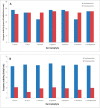Antifungal susceptibility and virulence factors of clinically isolated dermatophytes in Tehran, Iran
- PMID: 27092223
- PMCID: PMC4833739
Antifungal susceptibility and virulence factors of clinically isolated dermatophytes in Tehran, Iran
Abstract
Background and objectives: Dermatophytes possess a wide array of virulence factors and various antifungal susceptibility patterns which influence their pathogenesis in humans and animals. The aim of this study was to evaluate antifungal susceptibility and keratinase and proteinase activity of 49 dermatophyte strains from the genera Microsporum, Trichophyton and Epidermophyton which were isolated from human cases of dermatophytosis.
Materials and methods: Forty-nine dermatophyte strains isolated from clinical samples were cultured on general and specific culture media. Keratinase and proteinase activity was screened on solid mineral media and confirmed in liquid cultures. Drug susceptibility toward azoles (fluconazole, ketoconazole and itraconazole), griseofulvin and terbinafine was evaluated using disk diffusion method on Mueller-Hinton agar and minimum inhibitory concentrations (MICs) were determined using microbroth dilution assay according to the Clinical and Laboratory Standards Institute (CLSI) guidelines.
Results: Our results indicated that clinically isolated dermatophytes from 7 major species produced keratinase and proteinase at different extents. The mean keratinase and proteinase activity was reported as 6.69 ± 0.31 (U/ml) and 2.10 ± 0.22 (U/ml) respectively. Disk diffusion and microbroth dilution (MIC) results of antifungal susceptibility testing showed that ketoconazole was the most effective drug against Epidermophyton floccosum and Trichophyton mentagrophytes, itraconazole against T. rubrum and E. floccosum, and griseofulvin and terbinafine against Trichophyton verrucosum. Our results showed that all dermatophyte isolates were resistant to fluconazole. Overall, ketoconazole and itraconazole were the most effective drugs for all dermatophyte species tested.
Conclusion: Our results showed that antifungal susceptibility testing is an urgent need to select drugs of choice for treatment of different types of dermatophytosis and further indicated the importance of keratinase and proteinase in pathogenesis of dermatophyte species.
Keywords: Antifungal susceptibility testing; Dermatophytes; Keratinase activity; Proteinase activity; Virulence factors.
Figures
Similar articles
-
In vitro activities of antifungal drugs against dermatophytes isolated in Tokat, Turkey.Int J Dermatol. 2013 Dec;52(12):1557-60. doi: 10.1111/ijd.12100. Epub 2013 Oct 18. Int J Dermatol. 2013. PMID: 24134487
-
Antifungal drug susceptibility profile of clinically important dermatophytes and determination of point mutations in terbinafine-resistant isolates.Eur J Clin Microbiol Infect Dis. 2018 Oct;37(10):1841-1846. doi: 10.1007/s10096-018-3317-4. Epub 2018 Jul 7. Eur J Clin Microbiol Infect Dis. 2018. PMID: 29980898
-
Determination of minimum inhibitory concentrations of itraconazole, terbinafine and ketoconazole against dermatophyte species by broth microdilution method.Indian J Med Microbiol. 2015 Oct-Dec;33(4):533-7. doi: 10.4103/0255-0857.167341. Indian J Med Microbiol. 2015. PMID: 26470960
-
Antifungal Combinations in Dermatophytes.J Fungi (Basel). 2021 Sep 5;7(9):727. doi: 10.3390/jof7090727. J Fungi (Basel). 2021. PMID: 34575765 Free PMC article. Review.
-
Dermatophyte Infections Worldwide: Increase in Incidence and Associated Antifungal Resistance.Life (Basel). 2023 Dec 19;14(1):1. doi: 10.3390/life14010001. Life (Basel). 2023. PMID: 38276250 Free PMC article. Review.
Cited by
-
Phylogeny, Antifungal Susceptibility, and Point Mutations of SQLE Gene in Major Pathogenic Dermatophytes Isolated From Clinical Dermatophytosis.Front Cell Infect Microbiol. 2022 Mar 18;12:851769. doi: 10.3389/fcimb.2022.851769. eCollection 2022. Front Cell Infect Microbiol. 2022. PMID: 35372131 Free PMC article.
-
Clinico-mycological profile of tinea capitis and its comparative response to griseofulvin versus terbinafine.Curr Med Mycol. 2019 Mar;5(1):15-20. doi: 10.18502/cmm.5.1.532. Curr Med Mycol. 2019. PMID: 31049453 Free PMC article.
-
Low in vitro activity of sertaconazole against clinical isolates of dermatophyte.Curr Med Mycol. 2020;6(1):36-41. doi: 10.18502/cmm.6.1.2507. Curr Med Mycol. 2020. PMID: 32420506 Free PMC article.
-
Therapy and Antifungal Susceptibility Profile of Microsporum canis.J Fungi (Basel). 2018 Sep 5;4(3):107. doi: 10.3390/jof4030107. J Fungi (Basel). 2018. PMID: 30189676 Free PMC article. Review.
-
Screening of Marine Bioactive Antimicrobial Compounds for Plant Pathogens.Mar Drugs. 2021 Jan 28;19(2):69. doi: 10.3390/md19020069. Mar Drugs. 2021. PMID: 33525648 Free PMC article. Review.
References
-
- Ameen M. Epidemiology of superficial fungal infections. J Clin Dermatol 2010;28: 197– 201. - PubMed
-
- Havlickova B, Czaika VA. Epidemiological trends in skin mycoses worldwide. Mycoses 2008; 51: 2– 15. - PubMed
-
- Jankowska- Konsur A, Dylag M, Hryncewicz- Gwozdz A, Plomer-Niezgoda E, Szepietowski CJ. A 5-year survey of dermatomycoses in southwest Poland, years 2003–2007. Mycoses 2011; 54: 162– 167. - PubMed
-
- Oyeka CA, Eze II. Fungal skin infections among prison inmates in Abakaliki, Nigeria. Mycoses 2007;51: 50– 54. - PubMed
LinkOut - more resources
Full Text Sources


